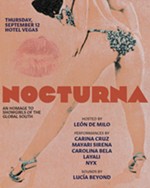Visual Art Review: Carl Cheng’s “Nature Never Loses”
The Contemporary's exhibit showcases the artist's fearlessness in the face of extinction
Reviewed by Cat McCarrey, Fri., Sept. 13, 2024

Who decides the everlasting artistic canon? Is it only traditional works shown in traditional venues, or can it recognize the innovative outsiders? It’s a question that gets even thornier when we look at styles like earth art, pieces designed to change and wear away with time.
The Contemporary took that challenge head-on, working over the past four years to craft and curate a six-decade retrospective of renegade artist Carl Cheng’s work. “Nature Never Loses” is the fruit of years of interviewing, scanning, and digging through archival footage of Cheng’s often intangible work. As head curator Alex Klein stated while chatting with Cheng at the Contemporary last Sunday, “It was a really daunting task to think about how to even begin to organize this show, because Carl works across so many different media.”

He’s a photographer, but also created three-dimensional models of his photos. He’s made installations on the roof of his studio, studying how nature changes materials over time. He’s painstakingly crafted futuristic ecological products under his artistic alter ego, the fictional John Doe Company. He’s dabbled in what art can be and how it progresses over time. How does a gallery retrospect something so vast?
Luckily, the Contemporary shied away from chronological organization. “It’s very hard to date Carl’s work because oftentimes he’ll be working on them for several decades. Then he’ll put different dates on them,” noted Klein in the artist talk, “because he thinks that his work, like technology, is constantly upgrading.”
Taking cues from ideas of upgrades and technological similarities, the Contemporary grouped Cheng’s work in five loose exhibits: “Photography as a Tool,” “Natural Processes and Nature Machines,” “Travel and Specimens,” “Art Tools,” and work produced as John Doe Co. Walking through the flow of artwork is less like a remote art display and more like a thematic journey through a science museum. Objects feel like experiments. When examined, worlds reveal themselves. It just takes a closer look to see the universe within.
The one constant is how pieces meld the natural world with distinctly human ingenuity. It starts slowly, like the photos in the “Scroll Series,” where an unrolled paper border makes a scene within a scene, illuminating the attempt to capture the wild expanses. This extends to pieces like V.H., where photographed subjects are preserved in bubbles of molded plastic and Plexiglas. It’s more layers of artifice and untamed nature.
Other works hint at the tension between environmental chaos and human control. Cheng’s Erosion Machine series is the ultimate study of trying to exert control over nature, as pumped water mimics the erosive process within a metal box. What’s eroded is a collection of “human rocks,” the name Cheng gives to obsolete mass-produced materials (like a broken toaster) that he’s crafted into preternaturally perfect structures. These smooth cones and squares, formed from crushed bottles or corroded electronics, shrink underneath glowing water effects. It’s an ouroboros: Is the natural process the conqueror or the manufactured items?
These motifs continue through the exhibit. They’re in the Nature Laboratory Collection 3.0 – a sterile greenhouse of elaborately carved avocado pits and skins, creating entire cities with the castoff compost scraps – and in emotional tools, where primitive picks and paintbrushes show unexpected organic elements: thorns or bones forming a foundation of crafted materials.
As John Doe Co., Cheng pushed these ideas into actual manufacturing, creating advertising for fantastical future products. These melded light and space, continuing with natural connection. This is where Alternative TV boxes fill with plastic plant and rock vignettes. Or where an Emergency Nature Supply Kit releases grass and bird sounds, complete with a commercial extolling its virtuous fight against bleak urbanization. All these ideas coalesce in his Organic Visualizer/Assembler, a massive tube, like a medical monstrosity in the dark. But it isn’t meant to hold any human; it’s meant to hold worlds subject to human whim. Inside the structure, a cylinder turns. The viewer can use pedals to spotlight portions, revealing intricate worlds carved from rocks and shells, miniature lights and squiggles. It’s an omnipotent feeling, looking down upon these creations, the LED lights and slight sound of the turning structure adding to the remove. It’s God-like.
Cheng discussed his work with the concept of the Anthropocene Age, which is “sort of like the dinosaur age. You know, it came and it went. That kind of predicts that as a human being, we’re going to be extinct. Because we’re going to destroy ourselves and what we think of our nature, but then nature never loses.” He’s beatific as he discusses it. No fear, just completely soothing. We might cease. But that’s technology. It’s progression. And there’s nothing more natural.
“Carl Cheng: Nature Never Loses”
The Contemporary Austin – Jones Center
Through Dec. 8
After this premiere, “Carl Cheng: Nature Never Loses” will travel to Institute of Contemporary Art, University of Pennsylvania (ICA) (Jan. 17, 2025 – April 6, 2025, modified version on view from April 25 – June 8, 2025); Bonnefanten (May 9, 2025 – Sept. 28, 2025); Museum Tinguely (Dec. 3, 2025 – May 10, 2026); Institute of Contemporary Art, Los Angeles (Sept. 26, 2026 – Feb. 28, 2027).












